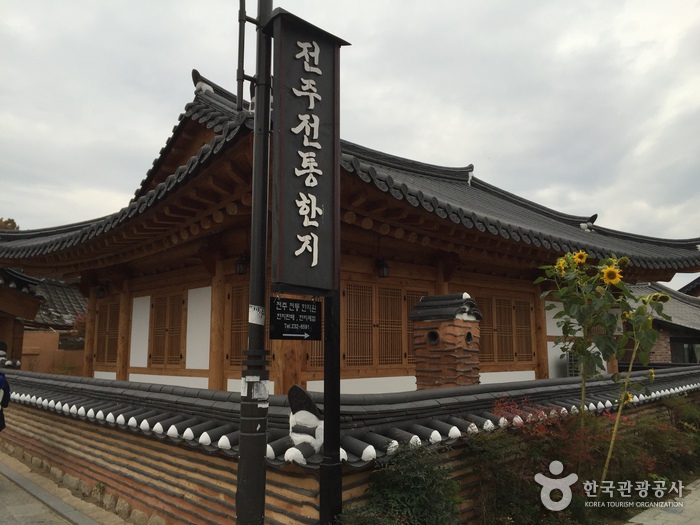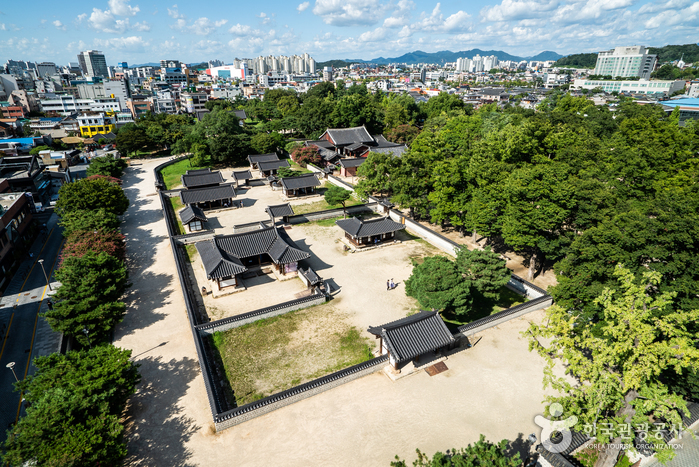Hanok Garden in Jeonju [Korea Quality] / 전주한옥마당 [한국관광 품질인증]
237.3944242596073m 251 2024-04-07
80-13 , Jeonjucheondong-ro, Wansan-gu, Jeonju-si, Jeonbuk-do
+82-10-9494-4579
Jeonju Hanok Garden in Jeonju Hanok Village, Jeollabuk-do, is a guesthouse combining traditional hanok charm with modern comfort. All guestrooms have a modern bathroom and toilet and a toenmaru wooden porch, while two rooms (Hope and Faith) have an additional inner floors attached to it. The room interiors have exposed wooden beams and hanji-covered walls and doors. From any room, guests enjoy a view of the beautiful yard with its jangdokdae jar store, flower pots and young pine trees.
Gangam Calligraphy Museum (강암서예관)
243.48981327708802m 14623 2024-04-07
74, Jeonjucheondong-ro, Wansan-gu, Jeonju-si, Jeonbuk-do
+82-63-285-7442
The Gangam Calligraphy Museum (est. 1995) in Jeonju Hanok Village has on display over 1,000 works from famous artists such as Kim Jeong-hee (1786-1856, calligrapher, painter, & scholar), Lee Sam-man (1770-1847, calligrapher), Kim Hong-do (1745-?, artist), and Jeong Yak-yong (1762-1836, scholar). This museum also houses a seminar room for calligraphy-related events and educational programs.
Samrockhon [Korea Quality] / 삼락헌 [한국관광 품질인증]Samrockhon [Korea Quality] / 삼락헌 [한국관광 품질인증]
248.93013384583946m 7345 2024-04-07
47-8 , Eunhaeng-ro, Wansan-gu, Jeonju-si, Jeonbuk-do
+82-10-2604-7358
Samrakheon is a traditional lodging in Jeonju Hanok Village, Jeollabuk-do, and sister hanok to Bukyeongdang. Samrakheon is a spacious old house containing duplex rooms equipped with toilets. In the shared mini-kitchen, simple breakfasts are provided, with coffee, tea, and toast. Guests can sample traditional crafts skills such as Korean paper-making, Injeolmi rice cake making and pottery - and can also get discounts on hanbok wearing and traditional bike riding experiences. Local tourist information is available.
GaEunChae2 [Korea Quality] / 가은채2 [한국관광 품질인증]
254.22389007044194m 204 2024-04-07
100-20 , Hanji-gil, Wansan-gu, Jeonju-si, Jeonbuk-do
+82-63-284-7775, +82-10-6335-5267
Gaeunchae 2 is the sister hanok of Gaeunchae in Jeonju Hanok Village, Jeollabuk-do. It’s a traditional red clay-walled hanok with ondol underfloor heating, exposed roof beams and hanji wallpaper and flooring - creating a beautiful and distinctive hanok interior. It has a small hallway which is good for storing luggage or just to sit and chat. In the garden are sculpted stone lanterns and tigers. Local attractions such as Jeondong Cathedral and Gyeonggijeon Shrine are a short walk away.
Gyo Dong Sal Rae [Korea Quality] / 교동살래 [한국관광 품질인증]
257.5334573011103m 847 2024-04-07
66-1 , Jeonjucheondong-ro, Wansan-gu, Jeonju-si, Jeonbuk-do
+82-10-9043-6743
Gyodongsallae Hanok stands close to the Namcheongyo Bridge over the Jeonjucheon Stream in Wansan-gu, Jeonju, Jeollabuk-do. The sarangchae (men’s house), anchae (women’s house) and an outbuilding provide a total of 10 guestrooms - some traditional ondol-heated rooms, some rooms with beds and one attic room. There are flower beds in the yard, and the cozy interiors are decorated with elegant fabrics and paintings. Two of the sarangchae rooms have terraces offering fine views.
Hanok Stay Eosahwa [Korea Quality]한옥 어사화[한국관광 품질인증]
265.20378739357284m 1 2024-04-07
106-1 , Hanji-gil, Wansan-gu, Jeonju-si, Jeonbuk-do
+82-507-1383-3344
Eosahwa Hanok Stay, which stands in the center of Jeonju Hanok Village, Jeollabuk-do, was originally built as the residence of the Jeonju police chief; it’s unusually high for a hanok and faces south. A bed has been provided for guests unfamiliar with ondol sleeping, and two rather small rooms were put together to make a larger bedroom and living room. A healthy and delicious breakfast is provided. All the sights of Jeonju Hanok Village are nearby.
Seoro[Korea Quality] / 서로[한국관광 품질인증]
278.19873064092656m 8656 2024-04-07
100-12 , Hanji-gil, Wansan-gu, Jeonju-si, Jeonbuk-do
+82-10-4033-2610
Seoro is a traditional hanok accommodation located in the Jeonju Hanok Village that offers guests a peaceful and quiet atmosphere. There are 10 different types of rooms, including ondol-type rooms, duplex-type rooms, and pension-type rooms. Traditional Korean red clay and ondol floors are installed in each room using the traditional Korea gudeul method (underfloor heating system), and the finest Korean wonanggeumchim (lovebird bedding) are provided. At night, you can rest under the stars on the large yard or toenmaru (narrow wooden porch).
Jeonju Jeondong Catholic Cathedral (전주전동성당)
280.8467106941203m 52001 2024-05-27
51 Taejo-ro, Wansan-gu, Jeonju-si, Jeonbuk-do
Jeondong Catholic Cathedral in Jeonju was built in honor of Roman Catholic martyrs of the Joseon dynasty on the very same spot the martyrs lost their lives. The land was purchased by French Priest Baudenet in 1891 (28th year of King Gojong), but construction of the church did not begin until 1908. Construction was completed in 1914, a time during which Korea was under Japanese rule. Though originally built just outside of Pungnammun Gate, the site of the martyrs, the church was later moved to its current location for expansion.
The first Romanesque building in the Honam region, Jeondong Catholic Cathedral is made of gray and red bricks and bears a striking resemblance to the Myeongdong Cathedral in Seoul, also designed by Priest Poinel. Not only considered one of the most beautiful Catholic churches in Korea, some even go so far as to say it is one of the most beautiful structures in all of Korea, citing the church’s unique combination of Byzantine and Romanesque architectural styles. The rectangular building is topped with three Byzantine bell towers (to the right, center, and left) and boasts arched ceilings, several of which meet in the form of a cross.
It is interesting to note that some of the bricks used in construction of the church were made using materials from the Jeonjueupseong Walled Town, which was torn down by the Japanese. It is also said that the cornerstone of the church came from a wall of Jeonjueupseong Walled Town near Pungnammun Gate.
Jeonju Traditional Hanji Center (전주전통한지원)
286.06479711989937m 12430 2024-04-07
100-10, Hanji-gil, Wansan-gu, Jeonju-si, Jeonbuk-do
+82-10-8959-7757
Jeonju has been a major producer of quality hanji paper for more than a thousand years. In keeping with this proud tradition, the Jeonju Traditional Hanji Center aims to preserve traditional paper-making techniques and become a mainstay in the hanji industry. More than 80 percent of the paper produced at the center is exported to Japan while the rest is used in Korea. The center produces, exhibits, and sells hanji used for calligraphy, Oriental paintings, and crafts, as well as special “yellow earth” wallpaper hanji and charcoal hanji, said to provide certain health benefits. Visitors can also sign up for crafting classes, including first-hand experience at making hanji, imprinting patterns and drying the paper.
Gyeonggijeon Shrine (경기전)
294.30480842863153m 55855 2024-05-27
44 Taejo-ro, Wansan-gu, Jeonju-si, Jeonbuk-do
+82-63-281-2790
A registered Historic Site, Gyeonggijeon Shrine was erected in 1410 and holds the portrait of King Tae-jo, the founder of the Joseon dynasty. The shrine was originally given the name Eoyongjeon, but was changed to its current name in 1442, the 24th year of King Sejong the Great. The structure was partially destroyed during the Imjin War (1592-1598), and was restored in 1614.
![Hanok Garden in Jeonju [Korea Quality] / 전주한옥마당 [한국관광 품질인증]](http://tong.visitkorea.or.kr/cms/resource/43/2594443_image2_1.png)

![Samrockhon [Korea Quality] / 삼락헌 [한국관광 품질인증]Samrockhon [Korea Quality] / 삼락헌 [한국관광 품질인증]](http://tong.visitkorea.or.kr/cms/resource/02/2596602_image2_1.jpg)
![Gyo Dong Sal Rae [Korea Quality] / 교동살래 [한국관광 품질인증]](http://tong.visitkorea.or.kr/cms/resource/29/2999029_image2_1.jpg)
![Seoro[Korea Quality] / 서로[한국관광 품질인증]](http://tong.visitkorea.or.kr/cms/resource/38/2814938_image2_1.jpg)



 English
English
 한국어
한국어 日本語
日本語 中文(简体)
中文(简体) Deutsch
Deutsch Français
Français Español
Español Русский
Русский